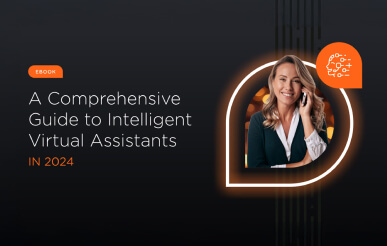Often, the top consideration when evaluating a Conversational AI solution is the technology itself. And while the technology is extremely important to build the foundation of a great virtual assistant, there are a lot of other considerations that should be top of mind as you evaluate your options.
Choosing, implementing, and maintaining a virtual assistant takes time. It is a dynamic and continuous process that requires strategy and resources. Rushing into a solution without properly evaluating the value that it will (or won’t) bring your business and customers is a reason that so many virtual assistant implementations fail. If a vendor promises an easy solution, they are not fully understanding what it takes to deliver an optimal customer experience.
You can view this situation compared to human agents the same way. If you train a human agent once, and then never update them on product releases, new information, or evaluate and give constructive feedback, then they will never improve to the level of customer experiences that is being demanded by consumers today.
All businesses will require different considerations to fit their specific needs, but here are our 6 suggestions that every business should highly consider before moving forward with a virtual assistant.
Who are you buying from?
This one is pretty straightforward. Does the company that you are buying from have a track record of providing high-quality and long-term virtual assistant solutions for your industry and use case? Are they focused specifically on Conversational AI, or is it one of the many various technology offerings they provide? It’s important to find a partner that can show that their solution can be geared towards the specific technical and design needs that you will require. All industries and use-cases are different, and choosing a partner that recognizes that is vital. A one-size-fits-all solution may work for some technologies, but Conversational AI needs to be designed in order to deliver the best customer experiences that are relevant and natural for your customers.
What is the pricing model?
Pricing models vary from company to company. If you look closely, pricing models can give you valuable insight into vendor strengths and focus areas. Here are a few common pricing models that you see with virtual assistant applications:
- Consumption based pricing model
- Fixed-fee
- Upfront costs/professional services fees
- Success-based pricing
We recommend finding a pricing model that incentivizes the vendor to continuously improve their application. Some models, like fixed-fee and upfront-costs, do not take into account the efficacy of the application.
What is their design philosophy?
Conversational AI is as much of an art as it is a science. Think about the way you speak, or the way you ask someone questions in order to find out information. There’s a lot more than just building AI models that goes into designing a high-quality virtual assistant. When evaluating a vendor, consider how they prioritize design in their solution. If they only prioritize their technology, then they may have a solid foundation, but not a positive end-result for customers. Often, virtual assistants without design expertise will feel clunky, robotic, and unnatural.
Is it a short-term or long-term solution?
Virtual assistants should be strategically implemented with a long-term solution in mind. While there are some easy fixes to customer experience problems, a virtual assistant takes time, effort, and a cohesive strategy for best results. Be ready to invest time in your implementation strategy, knowing that a fast-fix will likely need to be revisited or overhauled in a short period of time. And because a virtual assistant is directly customer-facing–in fact it can often be a customer’s first interaction with a brand–it’s important that the experiences that it delivers are consistent, cohesive, and fully represent the brand.
What is the post-implementation relationship?
This consideration can go hand-in-hand with a pricing strategy. Why? Conversational AI must be constantly tuned and trained for best results. If a vendor has a business model where they charge mainly for implementation or professional services, and less for the use or success of the application, then there is no skin in the game for the vendor to ensure that the application doesn’t only run well at first, but continues to run smoothly in the long-term.
Because the tuning and training of AI models is extremely important to maintain customer experience excellence, it’s important to know that your vendor will be as committed to the design and technical advancement of your application as they were when it was first installed. If the relationship does not sound like one that will be consistently optimizing the application, we suggest looking elsewhere.
How are the security and integration features?
Having all the necessary security certifications is important, but what really sets apart a good Conversational AI system is one that is designed (both on the technology and design side) to seamlessly integrate security protocols into the customer experience. This means that identification and authentication feel natural and a simple part of the conversation for the customer, while still being extremely effective to protect privacy.
To learn more about what to take into account when implementing a virtual assistant, check out our eBook.




